Like many with a penchant for historical fashion, the elegance of Victorian gowns often captivates my imagination. The layers, colors, ribbons, and overall sophistication of the era are undeniably alluring. As a woman deeply rooted in the American Southwest, an Arizona native with pioneer heritage now residing in Denver, I’ve been pondering the practicalities and styles of pioneer clothing. Specifically, how did the fashions of women on the Western frontier compare to the established styles of Eastern cities during the 19th century?
The pioneer woman’s wardrobe was a careful balance of necessity and aspiration. From practicality in harsh environments to maintaining a sense of decorum, their clothing choices were far from simple. This exploration delves into the essential elements of a Pioneer Woman Outfit, uncovering the foundational pieces and considerations that defined their style. This article will provide a basic overview, and future posts will delve deeper into specific aspects of pioneer fashion.
Defining the Frontier Context
For the scope of this discussion, “frontier” refers to the regions west of Missouri and Arkansas, spanning roughly from 1850 to 1890. The clothing and wardrobes described primarily represent those of women homesteaders and inhabitants of burgeoning settlement communities. The focus is mainly on the white settlers who migrated westward from the East, seeking new opportunities and lives.
What’s particularly fascinating is that frontier clothing was less dictated by social status and purchasing power, and more by the shared experience of pursuing dreams in the uncharted West. It reflected a commonality among families venturing into the unknown.
The Foundation: Underclothes
Interestingly, the undergarments worn by women in frontier areas were not drastically different from those in eastern cities. The chemise, a light cotton slip, was a fundamental piece, prioritized for hygiene and frequent washing. Pantalets, made of flannel or cotton, followed, serving purposes of modesty in a time before modern underwear.
Contrary to initial assumptions, corsets were a common element of a pioneer woman outfit. Many women journeying westward were driven by aspirations for a better future, be it economic or religious. These were women who valued propriety and would have considered a corset an essential garment, deeply ingrained in the fashion norms of the era.
While corsets might have been loosened or forgone during strenuous housework, most pioneer women brought corsets with them and wore them as often as circumstances allowed.
Petticoats, often multiple, were layered over the corset, adding volume to skirts and allowing for adjustments based on formality or weather. Stockings were a must when leaving the house or receiving guests, typically held up by garters or tucked into pantalets – a detail that might seem rather uncomfortable by today’s standards.
Fabrics of the Frontier
Calico emerged as the quintessential fabric for pioneer clothing. Often envisioned as quaint floral prints, calico is actually a type of plain-woven cotton fabric, slightly lighter than canvas. Its properties made it ideal for the frontier environment: lightweight, durable, and easy to clean. General stores offered calico in various dyed options, and women also dyed fabric themselves using commercially available dyes or natural pigments derived from plants like leaves, bark, berries, and fruits.
Cotton and silk fabrics were still reserved for “Sunday best” attire and more formal dresses. Many women brought finer garments with them as part of their pioneer woman outfit, intending them for special occasions.
While general stores provided access to fabrics, availability varied greatly depending on location and settlement density. In more remote areas, families often relied on homespun fabrics, a topic worthy of its own dedicated exploration.
Pioneer Woman Outfit: Daily Wear
 Pioneer woman in a simple dress and apron
Pioneer woman in a simple dress and apron
Regardless of their backgrounds, women in frontier settlements had to participate in the daily labor required to build and maintain homes and farms. Cooking, cleaning, childcare, laundry, and even field work filled their days. The success of frontier life depended on the physical contributions of each family member. Pioneer women quickly adapted to a life of manual labor.
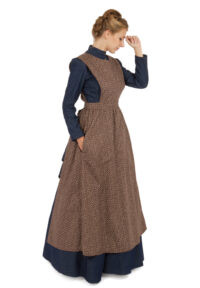 Pioneer woman's calico apron
Pioneer woman's calico apron
The prevailing dress styles of the time, characterized by fitted bodices and full skirts, were adapted into the pioneer woman outfit. Practical modifications were essential for frontier living. Skirts for everyday dresses were hemmed approximately three inches shorter to facilitate movement. Weights were sometimes sewn into the hems to prevent skirts from blowing up in windy conditions, maintaining modesty.
Bodices remained fitted, but sleeves were loosened, extending to the wrists, and paired with high collars for sun protection.
Laundering pioneer clothing was a significant undertaking. “Wash dresses,” made from easily washable white cotton with printed patterns, gained popularity around 1867. These practical two-piece dresses, available in stores and replicated by seamstresses, were adopted by women across socioeconomic levels for their easy care, demonstrating how fashion adapted to the demands of frontier life.
Sunday Best: Church and Community
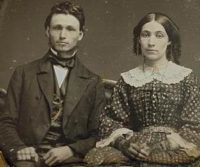 Frontier couple in their Sunday best attire
Frontier couple in their Sunday best attire
Even in sparsely populated areas, settlements often established churches, and regular attendance was a vital aspect of community life. While accounts exist of women in impoverished communities attending church barefoot, it was more common for women to have a designated “Sunday best” dress or two as part of their pioneer woman outfit. However, historical records tend to focus on more privileged settlers, making it challenging to ascertain the most typical experience.
A pioneer woman’s “Sunday best” mirrored fashionable city styles. Full skirts, worn over petticoats and corsets, were standard. Sleeve styles reflected current trends, including puffed bell, leg-o’-mutton, or pagoda sleeves. Skirt styles also followed fashion, transitioning through crinoline, hoop, and bustle silhouettes depending on the decade.
Younger and newly married women favored lighter colors for their Sunday dresses, transitioning to darker hues as they aged. These outfits were completed with the most fashionable hats available, along with kid gloves and low-heeled boots, demonstrating a commitment to style even on the frontier.
Social Occasions: Dances and Gatherings
When resources allowed, a pioneer woman outfit included a dress specifically for social events. Dances, holiday celebrations, picnics, and other community gatherings were important social outlets. As in eastern cities, women dressed for these occasions.
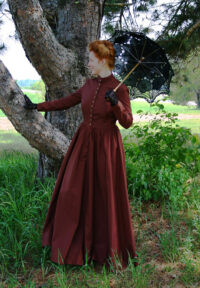 Pioneer woman's church dress
Pioneer woman's church dress
These social dresses were highly valued. Women might order fabrics from general stores and eagerly anticipate creating the latest styles. Godey’s Lady’s Book was a significant influence, with frontier women sharing and copying dress patterns and styles from its pages.
Fabric availability for these dresses depended heavily on proximity to towns and general stores. In many instances, women didn’t have an extensive wardrobe and would wear their best dress, enhancing it with accessories for special events. Hand-crocheted collars, shawls, and other accessories were popular ways to elevate a pioneer woman outfit for social occasions.
Accessories: The Finishing Touches
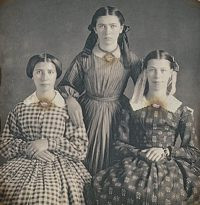 Frontier girls with bonnets and aprons
Frontier girls with bonnets and aprons
Accessories played a surprisingly significant role in the pioneer woman wardrobe. Beyond functional garments, jewelry and decorative items were highly valued. Pioneer women accessorized their outfits with:
- Aprons
- Boots
- Brooches
- Lockets
- Earrings
- Precious stones and metals (when available)
- Hair adornments
- Hats and Bonnets
- Collars and cuffs
- Gloves
- Undersleeves
- Parasols
- Fans
- Handbags
- Shawls
A Lasting Pioneer Legacy
Exploring pioneer clothing has deepened my appreciation for my own pioneer heritage. While “prairie style” and “western wear” are readily available today, understanding the historical context of pioneer women’s fashion reveals their resourcefulness in balancing propriety, beauty, and practicality in challenging frontier environments.
This exploration is just the beginning. Future articles will delve further into the fascinating world of pioneer accessories and other aspects of frontier fashion.
Recreate Your Pioneer Look
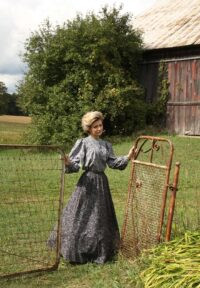 Woman wearing a pioneer style blouse and skirt
Woman wearing a pioneer style blouse and skirt
Browse our Pioneer Clothing Collection
Pioneer Calico Blouse and Skirt
Harper Victorian Pioneer Dress
Pioneer Blouse, Apron and Skirt Set

